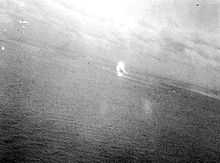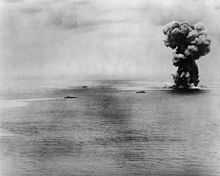Operation Ten-Go
| Operation Ten-Go 天號作戰 or 天号作戦 | |||||||
|---|---|---|---|---|---|---|---|
| Part of the Pacific Theater of World War II | |||||||
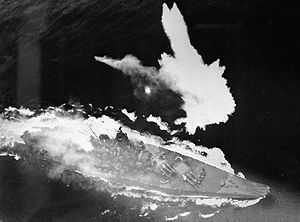 Yamato under attack. A large fire burns aft of her superstructure and she is low in the water from torpedo damage. | |||||||
| |||||||
| Belligerents | |||||||
|
|
| ||||||
| Commanders and leaders | |||||||
|
|
| ||||||
| Strength | |||||||
|
Task Force 58: 11 aircraft carriers 386 aircraft 6 battleships 11 cruisers 30+ destroyers |
2nd Fleet, Combined Fleet: 1 battleship 1 light cruiser 8 destroyers 115 aircraft, mostly kamikaze | ||||||
| Casualties and losses | |||||||
|
Attack on Yamato task force: 12 aircrew dead In kamikaze attacks: 85 killed & missing 122 wounded 1 carrier moderately damaged 1 battleship moderately damaged 1 destroyer heavily damaged |
Yamato task force: 3,700–4,250 dead[1] Kamikaze: 100 aircraft destroyed, 100+ dead | ||||||
Operation Ten-Go (天號作戰 (Kyūjitai) or 天号作戦 (Shinjitai) Ten-gō Sakusen) was the last major Japanese naval operation in the Pacific Theater of World War II. Other renderings of this operation's title in English include Operation Heaven One and Ten-ichi-gō.
In April 1945, the Japanese battleship Yamato (the largest battleship in the world)—along with nine other Japanese warships—embarked from Japan on a deliberate suicide attack upon Allied forces engaged in the Battle of Okinawa. The Japanese force was attacked, stopped, and almost completely destroyed by United States carrier-borne aircraft before reaching Okinawa. Yamato and five other Japanese warships were sunk.
The battle demonstrated U.S. air supremacy in the Pacific theater by this stage in the war and the vulnerability of surface ships without air cover to aerial attack. The battle also exhibited Japan's willingness to sacrifice entire ships, even the pride of its fleet, in desperate kamikaze attacks aimed at slowing the Allied advance on the Japanese home islands. This extremism reportedly contributed to the US decision to employ nuclear weapons against the Japanese.
Background
By early 1945, following the Solomon Islands campaign, the Battle of the Philippine Sea and the Battle of Leyte Gulf, the once formidable Imperial Japanese Navy's Combined Fleet was reduced to just a handful of operational warships and a few remaining aircraft and aircrew. Most of the remaining Japanese warships in the Combined Fleet were stationed at ports in Japan, with most of the large ships at Kure, Hiroshima.[2]
As a final step before the planned invasion of the Japanese home islands, Allied forces invaded Okinawa on 1 April 1945. In March, in briefing Emperor Hirohito on Japan's response to the expected Okinawan invasion, Japanese military leaders explained that the Japanese Imperial Army was planning extensive air attacks, including the use of kamikaze. The emperor then reportedly asked, "But what about the Navy? What are they doing to assist in defending Okinawa? Have we no more ships?" Now feeling pressured by the emperor to also mount some kind of attack, Japan's Navy commanders conceived a kamikaze-type mission for their remaining operational large ships, which included the battleship Yamato.[3]
The resulting plan—drafted under the direction of the Commander in Chief of the Combined Fleet, Admiral Toyoda Soemu[4]—called for Yamato and her escorts to attack the U.S. fleet supporting the U.S. troops landing on the west of the island. Yamato and her escorts were to fight their way to Okinawa and then beach themselves between Higashi and Yomitan and fight as shore batteries until they were destroyed. Once destroyed, the ship's surviving crewmembers were supposed to abandon the ships and fight U.S. forces on land. Very little, if any, air cover could be provided for the ships, which would render them almost helpless to concentrated attacks from US carrier-based aircraft.[3] In preparation for executing the plan, the assigned ships left Kure for Tokuyama, Yamaguchi, off Mitajiri, Japan, on 29 March.[5] However, despite obeying orders to prepare for the mission, Vice-Admiral Seiichi Itō—commander of the Ten-Go force—still refused to actually order his ships to carry it out, believing the plan to be futile and wasteful.[6]
Other commanders of the Imperial Japanese Navy also had very negative feelings about the operation, believing that it was a waste of human life and fuel. Captain Atsushi Ōi—who commanded escort fleets—was critical as fuel and resources were diverted from his operation. As he was told that the aim of this operation was "the tradition and the glory of Navy," he shouted:[7]
This war is of our nation and why should the honor of our "surface fleet" be more respected? Who cares about their glory? Damn fools!
- ("Surface fleet" refers to capital ships, especially battleships that "should have won the war".)
Vice Admiral Ryūnosuke Kusaka flew from Tokyo on 5 April to Tokuyama in a final attempt to convince the assembled commanders of the Combined Fleet—including Admiral Itō—to accept the plan. Upon first hearing of the proposed operation (it had been kept secret from most of them), the Combined Fleet commanders and captains unanimously joined Admiral Itō in rejecting it for the same reasons that he had expressed. Admiral Kusaka then explained that the Navy's attack would help divert U.S. aircraft away from the Army's planned kamikaze attacks on the U.S. fleet at Okinawa. He also explained that Japan's national leadership, including the emperor, were expecting the Navy to make their best effort to support the defense of Okinawa.
Upon hearing this, the Combined Fleet commanders relented and accepted the proposed plan. The ship's crews were briefed on the nature of the mission and given the opportunity to stay behind if desired — none did. However, approximately 80 crew members who were new, sick, or infirm, were ordered off the ships.[8] The ships' crews now engaged in some last-minute intense drills to prepare for the mission, mostly practicing damage-control procedures.[9] At midnight, the ships were fueled. Reportedly, in secret defiance of orders to provide the ships with only just enough fuel to reach Okinawa, the Tokuyama personnel actually gave Yamato and the other ships almost all of the remaining fuel in the port, although this probably still was not enough to allow the force to return to Japan from Okinawa.[10]
Battle
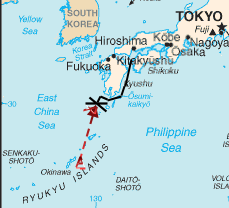
At 16:00 on 6 April, Yamato, with Admiral Ito on board, the light cruiser Yahagi and eight destroyers departed Tokuyama to begin the mission.[11] Two submarines—USS Threadfin and Hackleback—sighted the Japanese force as it proceeded south through Bungo Suido. Although they were unable to attack (due to the ships' speed), they did spend several hours shadowing the Japanese sortie and sending updates of its course to the U.S. fleet. The submarines' messages, which were reportedly sent uncoded, were also picked up by radio operators on the Japanese ships.[12]
At dawn on 7 April, the Japanese force passed the Ōsumi Peninsula into the open ocean heading south from Kyūshū toward Okinawa. They shifted into a defensive formation, with Yahagi leading Yamato and the eight destroyers deployed in a ring around the two larger ships, with each ship 1,500 m (1,600 yd) from each other and proceeding at 20 kn (23 mph; 37 km/h).[13] One of the Japanese destroyers—Asashimo—developed engine trouble and turned back. U.S. reconnaissance aircraft began to shadow the main force of ships. At 10:00, the Japanese force turned west to make it look like they were withdrawing, but at 11:30, after being detected by two American PBM Mariner flying boats (the Yamato fired a salvo with her 460 mm (18.1 in) bow guns using special "beehive shells" (三式焼散弾 (san-shiki shōsan dan) but could not prevent the two planes from shadowing the Japanese force), they turned back towards Okinawa.[8]
Upon receiving contact reports early on 7 April, U.S. 5th Fleet commander Admiral Raymond Spruance ordered Task Force 54, which consisted of older battleships under the command of Admiral Morton Deyo (which were engaged in shore bombardment), to intercept and destroy the Japanese sortie. Deyo moved to execute his orders, but Vice Admiral Marc A. Mitscher, who commanded Task Force 58 (TF 58), preempted Spruance and Deyo by launching a massive air strike from his carriers, without informing Spruance until after the launches were completed.[14]
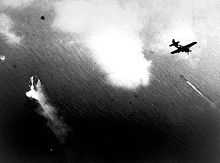
Around 10:00 on 7 April, Task Groups 58.1 and 58.3 (TG 58.1 and 58.3) began launching almost 400 aircraft in several waves from eight carriers (TG 58.1: USS Hornet, USS Bennington (CV-20), Belleau Wood, San Jacinto; TG 58.3 USS Essex, Bunker Hill, Hancock and Bataan) that were located just east of Okinawa. The aircraft consisted of F6F Hellcat and F4U Corsair fighters, SB2C Helldiver dive bombers, and TBF Avenger torpedo bombers. After being informed of Mitscher's launches, Spruance agreed that the airstrikes could go ahead as planned. As a contingency, Spruance ordered Admiral Deyo to assemble a force of six battleships (USS Massachusetts, Indiana, New Jersey, South Dakota, Wisconsin, and Missouri), together with seven cruisers (including the battlecruisers USS Alaska and Guam) and 21 destroyers, and to prepare for a surface engagement with Yamato should the airstrikes prove unsuccessful.[16][17]
Around 12:00, the first American aircraft arrived over the Yamato; these were F6F Hellcat and F4U Corsair fighters, which were under orders to deal with any Japanese aircraft that might appear to defend the ships below. None did.[18]
Since it soon became obvious that the Japanese force had no air cover, the U.S. aircraft were able to set up for their attacks without fear of opposition from Japanese aircraft. U.S. bomber and torpedo aircraft arriving over the Yamato group—after their two-hour flight from Okinawa—were thus able to circle the Japanese ship formation just out of anti-aircraft range in order to methodically set up their attacks on the warships below.[8] The first wave of U.S. carrier planes were spotted by a Japanese lookout on the bridge at 12:32. Two minutes later, Yamato opened fire with her 460mm main batteries. The Japanese ships stopped zigzagging and increased speed to 24 kn (28 mph; 44 km/h), beginning evasive maneuvers, and opened fire with their anti-aircraft guns. Yamato carried almost 150 anti-aircraft guns, including her massive 460 mm guns which could fire special "Common Type 3" anti-aircraft shells, known to the Japanese as "Sanshiki".[19] The U.S. torpedo airplanes mainly attacked from the port side so that if the torpedoes mainly hit from that side, it would increase the likelihood of the target ship capsizing.[20]
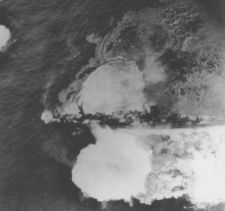
At 12:46, a torpedo hit Yahagi directly in her engine room, killing the entire engineering room crew and bringing her to a complete stop. Yahagi was hit by at least six more torpedoes and 12 bombs by succeeding waves of air attacks. The Japanese destroyer Isokaze attempted to come to Yahagi 's aid but was attacked and heavily damaged, and sank sometime later. Yahagi capsized and sank at 14:05.[22]
During the first attack wave, despite intensive evasive maneuvers that caused most of the bombs and torpedoes aimed at her to miss, Yamato was hit by two armor-piercing bombs and one torpedo.[23] Her speed was not affected, but one of the bombs started a fire aft of the superstructure that was not extinguished. Also, during the first attack wave, Japanese destroyers Hamakaze and Suzutsuki were heavily damaged and taken out of the battle. Hamakaze sank later.[21]
At 13:00 exact, Yamato changed course to 180 degrees heading south.
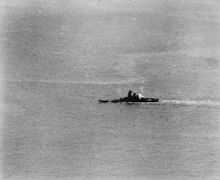
Between 13:20 and 14:15, the second and third waves of U.S. aircraft attacked, heavily concentrating on Yamato. During this time, Yamato was hit by at least eight torpedoes and up to 15 bombs. The bombs did extensive damage to the topside of the ship, including knocking out power to the gun directors and forcing the anti-aircraft guns to be individually and manually aimed and fired, greatly reducing their effectiveness.[24] The torpedo hits—almost all on the port side—caused Yamato to list enough that capsizing was now an imminent danger.[25] The water damage-control station had been destroyed by a bomb hit making it impossible to counter-flood the specially designed spaces within the ship's hull to counteract hull damage. At 13:33, in a desperate attempt to keep the ship from capsizing, Yamato 's damage control team counter-flooded both starboard engine and boiler rooms. This mitigated the danger but also drowned the several hundred crewmen manning those stations, who were given no notice that their compartments were about to fill with water.[26][27] The loss of the starboard engines—plus the weight of the water—caused Yamato to slow to about 10 kn (12 mph; 19 km/h).[28] At that same moment, the Americans launched another 110 aircraft from Task Group 58. Twenty Avengers made a new torpedo run from 60 degrees to port. Yamato started a sharp turn to port but three torpedoes ripped into her port side amidships, jamming her auxiliary rudder in position hard port.[29]
With Yamato proceeding more slowly and therefore easier to target, U.S. torpedo aircraft concentrated on hitting her rudder and stern with torpedoes in order to affect her steering ability, which they succeeded in doing.[30] At 14:02, after being informed that the ship could no longer steer and was unavoidably sinking, Admiral Ito ordered the mission canceled, the crew to abandon ship, and for the remaining ships to begin rescuing survivors.[21] Yamato communicated this message to the other surviving ships by signal flag because her radios had been destroyed.[31]
At 14:05, Yamato was stopped dead in the water and began to capsize. Admiral Ito and Captain Aruga refused to abandon her with the rest of the survivors. At 14:20, Yamato capsized completely and began to sink (30°22′N 128°04′E / 30.367°N 128.067°E). At 14:23, she suddenly blew up with an explosion so large that it was reportedly heard and seen 200 km (110 nmi; 120 mi) away in Kagoshima and sent up a mushroom-shaped cloud almost 20,000 ft (6,100 m) into the air.[32] It is claimed that her large explosion downed several U.S planes observing her end.[32] The explosion is believed to have occurred when the fires ignited by bomb hits reached the main magazines.[33]
Attempting to make it back to port, Japanese destroyer Asashimo was bombed and sunk with all hands by U.S. aircraft. The Japanese destroyer Kasumi was also crippled by U.S. carrier aircraft attack during the battle and had to be scuttled by other, relatively undamaged Japanese destroyers. Suzutsuki—despite her bow being blown off—was able to make it to Sasebo, Japan, by steaming in reverse the entire way.[21]
The remaining three less-damaged Japanese destroyers (Fuyuzuki, Yukikaze, and Hatsushimo) were able to rescue 280 survivors from Yamato (sources differ on the size of Yamato 's crew, giving it as between 2,750 and 3,300 men), plus 555 survivors from Yahagi (out of a crew of 1,000) and just over 800 survivors from Isokaze, Hamakaze, and Kasumi. Between 3,700 and 4,250 Japanese naval personnel perished in the battle.[21][34] The ships took the survivors to Sasebo.[35]
A total of 10 U.S. aircraft were shot down by anti-aircraft fire from the Japanese ships; some of the aircrews were rescued by seaplane or submarine. In total, the U.S. lost 12 men. Some of the Japanese survivors reported that U.S. fighter aircraft machine-gunned Japanese survivors floating in the water.[36][37] Japanese survivors also reported that U.S. aircraft temporarily halted their attacks on the Japanese destroyers during the time that the destroyers were busy picking up survivors from the water.[38]
During the battle, the Japanese Army conducted an air attack on the U.S. naval fleet at Okinawa as promised, but they failed to sink any ships. Around 115 aircraft—many of them kamikaze—attacked the U.S. ships throughout the day of 7 April. Kamikaze aircraft hit USS Hancock, battleship USS Maryland, and destroyer USS Bennett, causing moderate damage to Hancock and Maryland and heavy damage to Bennett. About 100 of the Japanese aircraft were lost in the attack.[39]
Aftermath
Ten-Go was the last major Japanese naval operation of the war, and the remaining Japanese warships had little involvement in combat operations for the rest of the conflict. Suzutsuki was never repaired. Fuyuzuki was repaired but hit a U.S. air-dropped mine at Moji, Japan, on 20 August 1945, and was not subsequently repaired. Yukikaze survived the war almost undamaged. Hatsushimo hit a U.S. air-dropped mine on 30 July 1945, near Maizuru, Japan, and was the 129th, and last, Japanese destroyer sunk in the war.[40]
Maryland was kept out of the war following the kamikaze attacks.
Okinawa was declared secure by Allied forces on 21 June 1945,[41] after an intense and costly battle. Japan surrendered in August 1945, after being bombed twice with atomic weapons. The apparent willingness of Japan to sacrifice so many of its people using suicidal tactics such as Operation Ten-Go and in the Battle of Okinawa reportedly was a factor in the American decision to employ atomic weapons against Japan.[42]
The story of Operation Ten-Go is revered to some degree in modern Japan as evidenced by appearances of the story in popular Japanese culture which usually portray the event as a brave, selfless, but futile, symbolic effort by the participating Japanese sailors to defend their homeland.[43] One of the reasons the event may have such significance in Japanese culture is that the word Yamato was often used as a poetic name for Japan. Thus, the end of battleship Yamato could serve as a metaphor for the end of the Japanese empire.[44]
See also
- Jun Henmi
- Japanese battleship Yamato
- Otoko-tachi no Yamato (男たちの大和, lit. "The Men's Yamato"), a 2005 Japanese war film based on a book by Jun Henmi.
Notes
- ↑ Jentshura and CombinedFleet.com. Abe, Saburo, Tokko Yamato Kantai (The Special Attack Fleet Yamato)", Kasumi Syuppan Co. 1995, a Japanese book which has apparently not been translated into English, gives the following breakdown in deaths for the Japanese in the operation: Yamato- 3056 killed, 276 survivors; Yahagi- 446 killed; Isokaze- 20 killed; Hamakaze- 100 killed; Yukikaze- 3 killed; Kasumi- 17 killed; Asashimo- 326 killed (all hands); Fuyuzuki- 12 killed; Suzutsuki- 57 killed.
- ↑ Hara, Japanese Destroyer Captain, 274.
- ↑ 3.0 3.1 Feifer, The Battle of Okinawa, 7.
- ↑ Minear, Requiem, xiii.
- ↑ Yoshida, Requiem, 6–7.
- ↑ Yoshida, Requiem, 62.
- ↑ Atsushi Ōi, Kaijō Goeisen.
- ↑ 8.0 8.1 8.2 Hara, Japanese Destroyer Captain, 277.
- ↑ Yoshida, Requiem, 15.
- ↑ Spurr, A Glorious Way to Die, 162–165.
- ↑ Yoshida, Requiem, 30.
- ↑ Skulski, The Battleship Yamato, 12. The eight Japanese destroyers involved in the operation were: Isokaze, Hamakaze, Yukikaze, Kasumi, Hatsushimo, Asashimo, Fuyuzuki and Suzutsuki.
- ↑ Yoshida, Requiem, 47–49.
- ↑ Triumph in the Pacific by E.B. Potter, also History of United States Naval Operations in World War II by Samuel Eliot Morison.
- ↑ 15.0 15.1 15.2 Nova: Sinking the Supership.
- ↑ Order of Battle - Final Sortie of the Imperial Japanese Navy - 7 April 1945
- ↑ Authors Garzke and Dulin speculate that the likely outcome of a battle between these two surface forces would have been a victory for the Allies, but at a serious cost due to the large margin of superiority Yamato held over the American battleships in firepower (460 mm vs. 356 mm), armour and speed (27 knots (50 km/h; 31 mph) vs. 21 knots (39 km/h; 24 mph). (Garzke and Dulin (1985)), p. 60.
- ↑ Garzke and Dulin (1985), pp. 60–61.
- ↑ Yoshida, Requiem, 62–64.
- ↑ Yoshida, Requiem, 74.
- ↑ 21.0 21.1 21.2 21.3 21.4 CombinedFleet.com
- ↑ Hara, Japanese Destroyer Captain, 298.
- ↑ Yoshida, Requiem, 66.
- ↑ Yoshida, Requiem, 78.
- ↑ Yoshida, Requiem, 80.
- ↑ Yoshida, Requiem, 82.
- ↑ Feifer, The Battle of Okinawa, 17–25.
- ↑ Yoshida, Requiem, 83.
- ↑ http://www.combinedfleet.com/yamato.htm
- ↑ Yoshida, Requiem, 95–96.
- ↑ Yoshida, Requiem, 108.
- ↑ 32.0 32.1 Yoshida, Requiem, 118.
- ↑ Skulski, The Battleship Yamato, 13.
- ↑ Jentshura, p. 39 says that 2,498 Yamato crewmen died. CombinedFleet.com says 3,063 on Yamato died. One possible reason for part of the discrepancy in the numbers is that Admiral Itō's staff may not have been included in the total ship's complement. Abe, Saburo, Tokko Yamato Kantai (The Special Attack Fleet Yamato)", Kasumi Syuppan Co. 1995, a Japanese book which has apparently not been translated into English, gives the following breakdown in deaths for the Japanese in the operation: Yamato- 3056 killed, 276 survivors; Yahagi- 446 killed; Isokaze- 20 killed; Hamakaze- 100 killed; Yukikaze- 3 killed; Kasumi- 17 killed; Asashimo- 326 killed (all hands); Fuyuzuki- 12 killed; Suzutsuki- 57 killed.
- ↑ Yoshida, Requiem, 140.
- ↑ "Then the Americans started to shoot with machine guns at the people who were floating, so we all had to dive under." Naoyoshi Ishida; Keiko Bang (September 2005). "Survivor Stories: Ishida". Sinking the Supership. NOVA.
- ↑ Hara, Japanese Destroyer Captain, 301.
- ↑ Yoshida, Requiem, 144.
- ↑ Hara, Japanese Destroyer Captain, 304.
- ↑ Hara, Japanese Destroyer Captain, 281.
- ↑ Minear, Requiem, xiv.
- ↑ Feifer, The Battle of Okinawa, 410–430.
- ↑ IMDB.com (1990–2009). "Uchû senkan Yamato". Internet Movie Database. Retrieved 26 March 2009.; IMDB.com (2005). "Otoko-tachi no Yamato". Internet Movie Database. Retrieved 26 March 2009.
- ↑ Minear, Requiem, xvii.
References
- Feifer, George (2001). "Operation Heaven Number One". The Battle of Okinawa: The Blood and the Bomb. The Lyons Press. ISBN 1-58574-215-5.
- Garzke, William H.; Dulin, Robert O. (1985). Battleships: Axis and Neutral Battleships in World War II. Annapolis, Maryland: Naval Institute Press. ISBN 0-87021-101-3. OCLC 12613723.
- Hara, Tameichi (1961). "The Last Sortie". Japanese Destroyer Captain. New York & Toronto: Ballantine Books. ISBN 0-345-27894-1. A first-hand account of the battle by the captain of the Japanese cruiser Yahagi.
- Jentschura, Hansgeorg; Jung, Dieter; Mickel, Peter (1977). Warships of the Imperial Japanese Navy, 1869-1945. Annapolis, Maryland: United States Naval Institute. ISBN 0-87021-893-X.
- Ōi, Atsushi (1992). Kaijo Goeisen. Asahi Sonorama. ISBN 4-05-901040-5.
- Skulski, Janusz (1989). The Battleship Yamato. Annapolis, Maryland: Naval Institute Press. ISBN 0-87021-019-X.
- Spurr, Russell (1995). A Glorious Way to Die: The Kamikaze Mission of the Battleship Yamato, April 1945. Newmarket Press. ISBN 1-55704-248-9.
- Yoshida, Mitsuru; Minear, Richard H. (1999). Requiem for Battleship Yamato. Annapolis, Maryland: Naval Institute Press. ISBN 1-55750-544-6. A first-hand account of the battle by Yamato 's only surviving bridge officer.
External links
| Wikimedia Commons has media related to Operation Ten-Go. |
- "navweaps.com: Order of Battle".
- "CombinedFleet.com: Chronological history of Yamato and actions during Ten-Go".
- "NOVA documentary: Sinking the Supership". The official site of the NOVA documentary with additional information on the subject.
| ||||||||||||||||||||||||||||||||||||||||||||||||||||||||||||||||||||||||||||||||
